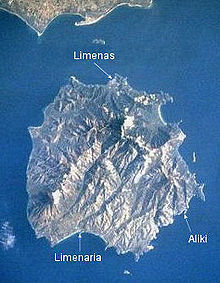Aliki
The Aliki peninsula is located on the southeast coast of the island of Thasos . In the area of the western bay, the place with its holiday homes and restaurants was built there in the last decades of the last century. Originally, these were simple stone huts (kalyves) built here, which the farmers of Theologos used to stay in the surrounding olive groves during the maintenance and harvest season.
history
The peninsula was known as an important marble quarry from ancient times and up to the Byzantine period. On the entire southeast side of the peninsula up to its southern tip, the mighty marble quarries extend without interruption from the 7th century BC. Were in production until the 7th century AD. At that time the marble was quarried down to a few meters above sea level. As a result of subsidence in the mountains, the deepest excavation level is flooded today. Graves, several grave steles and a large sarcophagus with Roman inscriptions have been excavated on the isthmus .
Presumably in connection with the extensive mining operations there was a sanctuary from archaic times in the eastern bay and an early Christian basilicas ensemble, high up on the northeast end of the peninsula.
The sanctuary dedicated to Apollo , which served as a place of sacrifice and accommodation for the faithful, was built in the 7th century BC. BC, the beginning of the colonization of the island by the Parier . The sanctuary consisted of two adjacent identical buildings of different sizes. To the west, the facades each have a vestibule with 5 Doric - monolithic columns between two pillars, light architraves , friezes with triglyphs and metopes , carefully executed. In the middle of each of the northern rooms there are hearths embedded in the floor. In the southern building, the hearth or sacrifice site is dated to 500 BC. And is considered to be the oldest Doric component on the island. The northern building consists of a primitive Ionic and a Doric component. The older Ionic was born in 470-465 BC. Replaced by a larger building. The upstream terrace, which today extends to the beach, dates from 530-525 BC. Two cult grottoes dedicated to Apollo from the 3rd century BC Were discovered south of the sanctuary. The place of worship was used until the island was Christianized.
The excavations of the sanctuary were carried out by Theodore Bent in 1887 . The most significant find was a masculine archaic statue, a kouros , which is now in the Istanbul Archaeological Museum . Inscriptions indicate the purpose of the sanctuary and its importance until the late Roman era. Graffiti on the facade of the northern building show wishes for a happy voyage for the ships laden with marble and thanks to the Dioscuri , the protectors of the seamen.
At the beginning of the 5th century, an ensemble of two basilicas with a few extensions was built on the peninsula. The larger southern one was built in the first quarter of the 5th century, in a second phase a narthex was added to the west . A monumental ambo shows that the basilica was very important. The north basilica was built with a single nave in the years 400-425, then expanded with three aisles around the year 500, provided with a courtyard in the west and later converted into an atrium with a baptistery . The ensemble showed its greatest development in the Justinian epoch and, like the quarries, was abandoned in the 7th century after the Slav invasion .
Web links
Individual evidence
- ↑ Y. Grandjean et F. Salviat: Guide de Thasos , p 161
Coordinates: 40 ° 36 ′ 17 ″ N , 24 ° 44 ′ 30 ″ E

